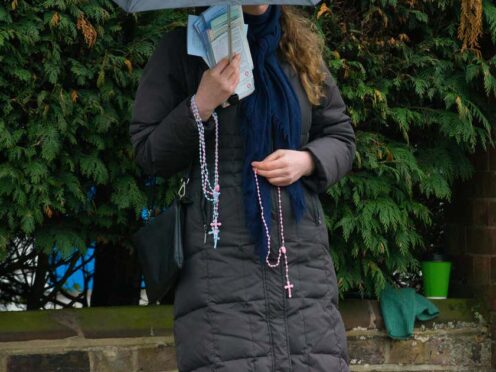
Campaigners have accused the Government of “dragging its heels” on ensuring women do not face harassment outside abortion clinics one year after safe access zones were signed into law.
Those supporting the law have raised concerns that it could be watered down in practice if silent prayer is not banned while anti-abortion groups have said this would threaten their freedom of expression and religious belief.
MPs voted to bring in legislation prohibiting protests within 150 metres of clinics or hospitals providing abortion services in England and Wales as part of the Public Order Act, which received royal assent on May 2 2023.
But that section of the Act covering so-called buffer zones has not yet been implemented, with final guidance about how it will work in practice yet to be published.
The Home Office has said it anticipates commencing Section 9 of the Act “no later than Spring 2024”, but no specific date has been given.
Draft guidance which went out for consultation in December raised concerns among pro-choice campaigners, with some claiming it did not reflect the debate in Parliament, which saw MPs vote against attempts to allow “silent prayer” outside clinics under the new law.
The proposed draft guidance stated that prayer itself within the zone “should not automatically be seen as unlawful”.
It added that “where an individual is praying, but their conduct is also intrusive, this is likely to be an offence”.
In March, Home Office minister Laura Farris rejected the notion that the Government is attempting to “water down” the legislation but said silent prayer is a “difficult category” when it comes to where the line falls between competing rights and obligations.
Home Secretary James Cleverly has previously said the final guidance will be based on feedback from the consultation and added that his department was “very conscious to make sure that the expressed will of Parliament is reflected in the ultimate guidance that is put out.”
A staff member at an abortion clinic in south London described it as “horrible to see women frightened and in tears after being intimidated” outside that facility, and said the wait for the zones to come into full force is “infuriating”.
Michaela McDaid, an operations service manager at the MSI Reproductive Choices clinic in Brixton, said: “Since the legislation was introduced, anti-choice groups have been getting worse and worse.
“They now follow people down the street, forcing information on them that they do not want.
“It’s horrible to see women frightened and in tears after being intimidated in this way.
“No-one knows what they have been through before coming to us and we are helpless without the zones in place.”
MSI Reproductive Choices, previously known as Marie Stopes International, said the wait in bringing the zones in is “completely unacceptable”.
Louise McCudden, the organisation’s UK head of external affairs, said: “Safe Access Zones, which protect women from abortion clinic harassment, were signed into law one year ago.
“Yet the Home Office is still dragging its heels on the implementation.”
Michael Robinson, executive director of the Society for the Protection of Unborn Children (SPUC), said it seeks to give information to women about alternative options to abortion.
He said: “The Government must not give in to the bullying tactics of the pro-abortion lobby and restrict the freedoms of campaigners to provide this helpful information, or just silently pray near a clinic.”
Right To Life UK said it believed “hundreds of women have been helped outside abortion clinics by pro-life volunteers who have provided them with practical support”.
Spokesperson Catherine Robinson said bringing in buffer zones “will mean that the vital practical support provided by volunteers outside abortion clinics will be removed for women”.
A Home Office spokesperson said: “It is completely unacceptable that anyone should feel harassed or intimidated whilst exercising their legal right to access abortion services.
“We are currently considering all responses to the consultation and final guidance will be published in due course.”
While councils can put Public Spaces Protection Orders (PSPOs) in place to have a similar effect as safe access zones, pro-choice campaigners have long made the case for the need for national legislation, arguing that PSPOs depend on local councils’ willingness, are timebound, can be expensive and result in a postcode lottery.

Enjoy the convenience of having The Sunday Post delivered as a digital ePaper straight to your smartphone, tablet or computer.
Subscribe for only £5.49 a month and enjoy all the benefits of the printed paper as a digital replica.
Subscribe